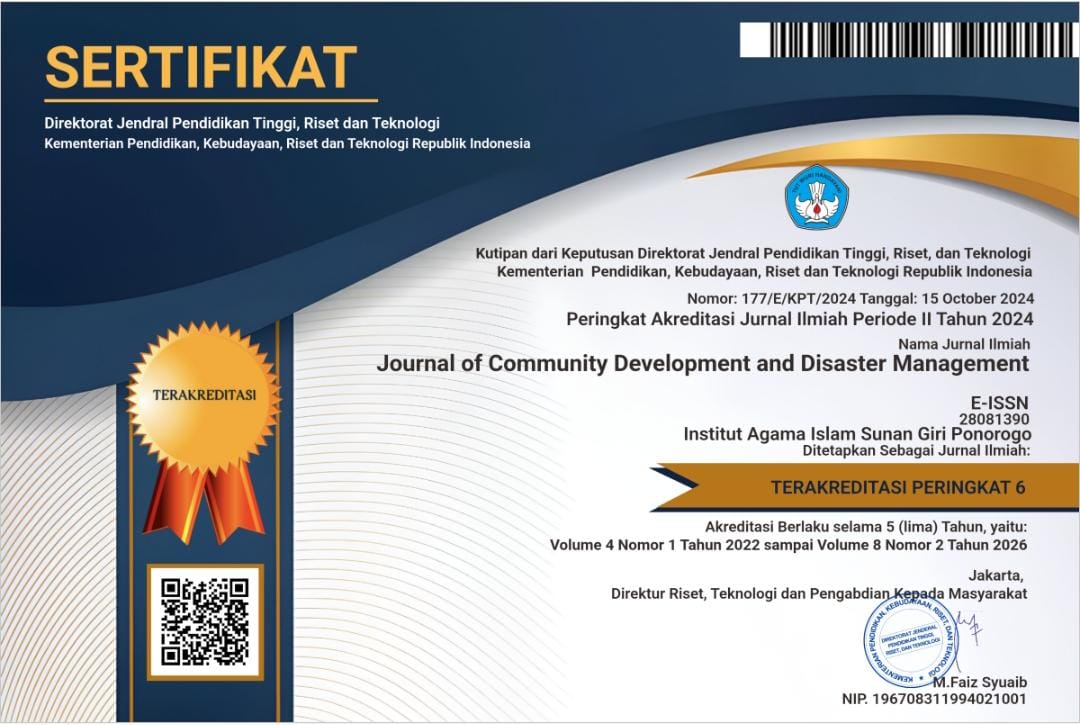Desiminasi Ideologi Jihadi Kaos Islam Anak-Anak Pada Distro Rafa Muslim Fashion Di Surakarta
Ideological Dissemination of Jihadi Islamic T-Shirts for Children at Rafa Muslim Fashion Distro in Surakarta
DOI:
https://doi.org/10.37680/jcd.v7i1.6756Keywords:
Dissemination Of The Ideology Of Jihadist, Radicalism, RMF Children's Islamic T-ShirtsAbstract
This article, study examines the dissemination of jihadist ideology among in Surakarta Muslim children through to clothing/fashion. This research takes the case study of Rafa Muslim Fashion (RMF). The RMF was chosen as the object of research because in Surakarta the massive desimination of jihad ideology through dakwa t-shirts. By taking, the RMF kidz jihadi children's shirts, this study answers the question of why jihadi actors spread the ideology of radicalism through Islamic t-shirts? What is the pattern of radicalism promoted by RMF in the Islamic Jihadi shirt? How did the children respond to the Muslim Jihadi kidz t-shirts? To answer this research, the author conducted field research at the RMF distribution in Surakarta. The author argues that Muslim children in Indonesia, especially, Ngeruki, Surakarta, are exposed to the ideology of jihad to fashion dakwa t-shirt is because of the introduction of heroic figures through Islamic t-shirts. Koas Islam is used as a medium for desimination jihadi ideology alternative by actors jihadi. Through dakwa t-shirts that are designed in a trendy, stylish and modern way, Muslim children are attracted to jihadi t-shirts.
References
Fealy, G. (2008). Consuming Islam: Comodified Religion and Aspirational Pietism in Contemporary Indonesia. In G. Fealy & S. White (Eds.), Ekspressing Islam: Religious Life and Politics in Indonesia (pp. 1–15). Institute od Southeast Asian Studies.
Hasan, N. (2006). Laskar Jihad, Islam, Militancy, and Quest for Identity in Post-New Order Indonesia. Cornel Southeast Asia Program.
Hasan, N. (2018a). Gagalnya Jihadisme di Kalangan Generasi Milenials. In hasan (Ed.), Literatur Keisalaman Generasi Milenial Transmisi, Apropriasi, dan Kontestasi. Suka Perss.
Hasan, N. (2018b). Gagalnya Jihadisme di Kalangan Generasi Milinial. In N. Hasan (Ed.), Literatur Keislaman Generasi Milenial Transmisi, Apropiasi dan Kontestasi (Noorhaidi, pp. 267–289). Suka Perss.
Helie, A. (2005). The US occupation and rising religious extremism: The double threat to women in Iraq. Women’s World, 24.
ICG. (2004). Indonesia Backgrounder: Why Salafism and Terrorism Mostly Adon’t Mix. 83.
Ikhwan, M. (2018). Produksi Wacana Islam di Indonesia Revitalisasi Islam Publik dan Politik Muslim” dalam Noorhaidi Hasan, dkk. Literatur Keisalaman Generasi Milenial Transmisi, Apropriasi, Dan Kontestasi. Yogyakarta: Pascasarjana UIN Sunan Kalijaga Perss, 109–142.
IPAC. (2017a). Mothers to Bombers: The Evolution of Indonesian Women Extremists. 35, 27. http://file.understandingconflict.org/file/2017/01/IPAC_Report_35.pdf
IPAC. (2017b). The Radicalisation of Indonesian Women Workers in Hong Kong. 39, 22. http://file.understandingconflict.org/file/2017/07/IPAC_Report_39.pdf
IPAC. (2018). The Surabaya Bombings and the Future of ISIS in Indonesia. 51. http://file.understandingconflict.org/file/2018/10/IPAC_Report_51.pdf
King, M., & Taylor, D. M. (2011). The Radicalization of Homegrown Jihadists: A Review of Theoretical Models and Social Psychological Evidence. Terrorism and Political Violence, 23(4).
Muhammad, A. (2008). Karamah Mujahidin Dari Masa Kemasa (1st ed.). Media Islamika.
Muzzaki, A. (2008). Islam as a Symbolic Commodity: Transmitting and Consumming Islam Public Sermons in Indonesia. In P. Kitiarsa (Ed.), Religious Commodification in Asia: Marketing Good (pp. 209–219). Routledge.
Noor, H. I. (2006). The role of kinship in Indonesia’s Jemaah Islamiya. Terrorism Monitor, 4.
Piazza, J. A. (2011). Poverty, minority economic discrimination, and domestic terrorism. Journal of Peace Research. https://doi.org/10.1177/0022343310397404.
Qodir, Z. (2016). Kaum Muda, Intoleransi dan Radikalisme Agama. Studi Pemuda, 5(2), 429–425.
R, L.-B. (2005). A peaceful Jihad: Negotiation Identity and Modernity in Muslim Java. Palgrave Macmillan.
R, L.-B. (2008). Commodification of Religion and the “religification” of Commodities. In Commodifications in Asia: Marketing Good (pp. 220–234). Routledge.
Saputra, E. (2019). Menelisik Radikalisme Gen Z Perempuan di Facebook. Islamica: Jurnal Studi Keislaman, 14(1), 103–130.
Savatore, A., & Echelman, D. (2004). Publis Islam and The Common Good (1st ed.). Brill.
Smit, R. (2009). Defining Professionalism in anti-Islamic Radicalism Policies.
Solahudin. (2011). NII Sampai JI: Salafi Jihadisme di Indonesia. Komunitas Bambu.
Tighe, E. (2011). Trust in Allah, But Tie Your Camel: The Effects of Radicalized Schooling and State Security on Islamic Terrorism in the Middle East. University of Georgia.
Triantoro, D. A., Husna, F., & Amna, A. (2018). Ruqyah Syar’iyyah: Alternatif Pengobatan, Kesalehan, Islamisme dan Pasar Islam. Harmoni, 17(2), 460–478.
Wiktorowicz, Q. (2006). anatomi of the Salafi Movement. Routledge.
Wildan, M. (2013). Mapping Radical Islam: A Study of the Poliferation of Radical Islam in Solo, Central Java. In M. Van Bruinessen (Ed.), Cotempory Developments in Indonesia Islam: Exsplaining the"Conservative Turn" (pp. 190–223). Institute of Southeast Asian Studies.
Yuswohady. (2017). Generasi M: Generation Muslim. Benteng Pustaka.
Internet Website/ Social Media
Instagram: @rafamuslimfashionstore; @raudhatulfata
Telegram: https://t.me/katalogprodukremajaanak
Downloads
Published
How to Cite
Issue
Section
License
JCD: Journal of Community Development and Disaster Management rekomendasi pencipta untuk memegang hak cipta tanpa batasan dan batasan pencipta untuk memiliki hak publikasi tanpa batasan, juga pemilik hak komersial atas artikel tersebut adalah pencipta.







